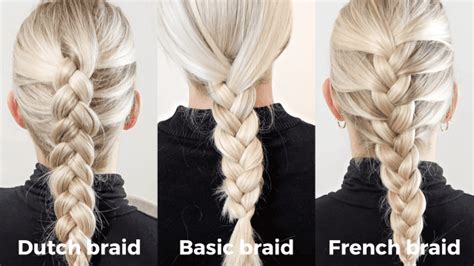Introduction
The Dutch and French braids are two of the most popular braiding techniques. They are both versatile and can be used to create a variety of looks, from elegant to casual. However, there are some key differences between the two techniques.

Dutch Braid
Definition: A Dutch braid is a three-strand braid in which the strands are crossed under each other instead of over each other. This creates a raised, textured effect.
Origins: The Dutch braid is believed to have originated in the Netherlands in the 16th century. It was originally called a “net braid” because it resembles a fishing net.
Popularity: The Dutch braid is a popular choice for both men and women. It is often used in formal hairstyles, such as weddings and proms.
French Braid
Definition: A French braid is a three-strand braid in which the strands are crossed over each other instead of under each other. This creates a flat, smooth effect.
Origins: The French braid is believed to have originated in France in the 17th century. It was originally called a “courtesan’s braid” because it was popular among courtesans.
Popularity: The French braid is a popular choice for women of all ages. It is often used in casual hairstyles, such as pigtails and ponytails.
Comparison
Technique: The main difference between the Dutch and French braids is the way in which the strands are crossed. In a Dutch braid, the strands are crossed under each other, while in a French braid, the strands are crossed over each other.
Appearance: The Dutch braid creates a raised, textured effect, while the French braid creates a flat, smooth effect.
Versatility: Both the Dutch and French braids are versatile and can be used to create a variety of looks. However, the Dutch braid is generally considered to be more formal than the French braid.
How to Braid
Dutch Braid:
- Start with clean, dry hair.
- Divide your hair into three equal sections.
- Cross the right section over the middle section.
- Cross the left section under the middle section.
- Repeat steps 3 and 4 until you reach the end of your hair.
- Secure the braid with a hair tie.
French Braid:
- Start with clean, dry hair.
- Divide your hair into three equal sections.
- Cross the left section over the middle section.
- Cross the right section under the middle section.
- Pick up a small section of hair from the right side and add it to the right section.
- Cross the right section over the middle section.
- Cross the left section under the middle section.
- Pick up a small section of hair from the left side and add it to the left section.
- Repeat steps 5-8 until you reach the end of your hair.
- Secure the braid with a hair tie.
Common Mistakes to Avoid
Dutch Braid:
- Crossing the strands under each other too tightly, which can create a bulky, uneven braid.
- Not crossing the strands under each other deeply enough, which can create a loose, sloppy braid.
- Adding too much hair to the sections, which can make the braid difficult to manage.
French Braid:
- Crossing the strands over each other too tightly, which can create a flat, lifeless braid.
- Not crossing the strands over each other deeply enough, which can create a loose, sloppy braid.
- Adding too little hair to the sections, which can make the braid thin and wispy.
- Not picking up hair from the sides of the head, which can create a narrow, unflattering braid.
Conclusion
The Dutch and French braids are two beautiful and versatile braiding techniques. With a little practice, you can master both techniques and create a variety of stylish hairstyles.
Tips and Tricks
- Use a small amount of hairspray to help keep the braid in place.
- If you have thick hair, try using a larger brush to section your hair.
- If you have fine hair, try using a smaller brush to section your hair.
- Practice makes perfect! The more you braid your hair, the better you will become at it.
- Don’t be afraid to experiment with different braiding techniques. There are many different ways to braid hair, so find one that works for you.
Why Braiding Matters
Braiding your hair is a great way to protect it from damage. When your hair is braided, it is less likely to get tangled or broken. Braiding can also help to reduce frizz and add volume to your hair.
Benefits of Braiding:
- Protects hair from damage
- Reduces frizz
- Adds volume to hair
- Can be used to create a variety of hairstyles
- Is a relatively inexpensive way to style your hair
